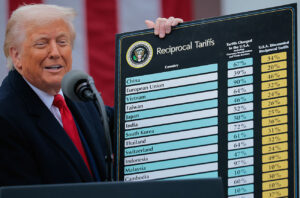US president Donald Trump announces ‘reciprocal tariffs’ at the White House on 2 April.
President Trump announced sweeping new US tariffs on many imports this week, with a baseline set at 10% but with some countries – including major wine-producing nations – facing higher rates.
There will be a 20% levy on goods from the European Union (EU) and 30% on imports from South Africa under president Trump’s reciprocal tariff plan, for example.
Wine wasn’t specifically mentioned in the announcement, but EU trade bodies said they understood wine would be hit alongside other products.
‘Targeting EU wine will only make losers on both sides of the Atlantic,’ said Marzia Varvaglione, newly elected president of wine trade body the Comité Européen des Enterprises Vins (CEEV).
Varvaglione warned of the prospect of ‘layoffs, deferred investments and price increases’.
The US is the largest export market for EU wines, with shipments worth €4.88bn in 2024 – 28% of the EU’s total wine export value.
France’s wine and spirits export federation, FEVS, said applying the new tariff to wine penalises businesses and ‘above all, American consumers’.
It warned the 20% levy could wipe approximately €800m off the value of French exports, and potentially €1.6bn off the total value of EU shipments.
‘The US wine market is fundamental for the economic sustainability of the EU wine sector,’ said the CEEV’s Varvaglione. ‘There is no alternative wine market that could compensate the loss of the US market.’
Some US importers had halted shipments of EU wines given the tariff uncertainty, and the CEEV previously estimated this was costing European wine companies €100m per week.
Across the Atlantic, anti-tariff lobby group the US Wine Trade Alliance said it was continuing to engage with policymakers in Washington DC.
US wines still barred from Canada, says Wine Institute
Tariffs were also harming US wineries’ access to consumers in Canada, according to the US Wine Institute.
It said Canada had already barred US wines in response to previously-announced US tariffs. Canada accounted for 35% of US wine exports prior to this, with a retail value of more than $1.1bn.
Wine Institute president and CEO Robert P. Koch said, ‘Today’s announcement of new tariffs will only make it harder for American wineries to regain access to Canada, by far our most important export market. In early March, Canada cleared its shelves of all U.S. wine and continues to block its sale.’
The Trump administration has argued that wide-ranging tariffs help to address long-standing trade imbalances and will also promote domestic manufacturing, in order to meet economic and national security goals.
The White House said this week, ‘A 2024 economic analysis found that a global tariff of 10% would grow the economy by $728bn, create 2.8 million jobs, and increase real household incomes by 5.7%.’
Wine trade bodies have called for a negotiated solution to keep the sector out of a wider trade battle.
Ignacio Sánchez Recarte, CEEV secretary-general, said, ‘The imposition of reciprocal duties on Transatlantic wine trade appears unjustified considering the minimal difference in duties between the EU and US tariffs on wine products. Together with our US colleagues, we have consistently opposed the imposition of tariffs for wine around the world and have consistently called to remove the duties applying in our markets.’
President Trump recently threatened 200% tariffs on EU wines and spirits, if the European Commission went ahead with plans to impose retaliatory levies on American whiskies in response to US aluminium and steel tariffs.
Related articles
EU unveils support plan for under-strain wine sector
US tariffs may wipe €1bn off Italian wine exports
Trump victory puts wine tariffs back in spotlight
The post Trump’s US tariffs may raise prices, warns EU wine body appeared first on Decanter.
